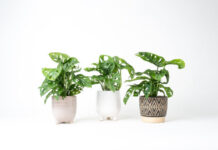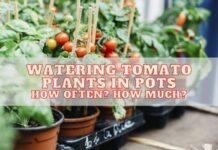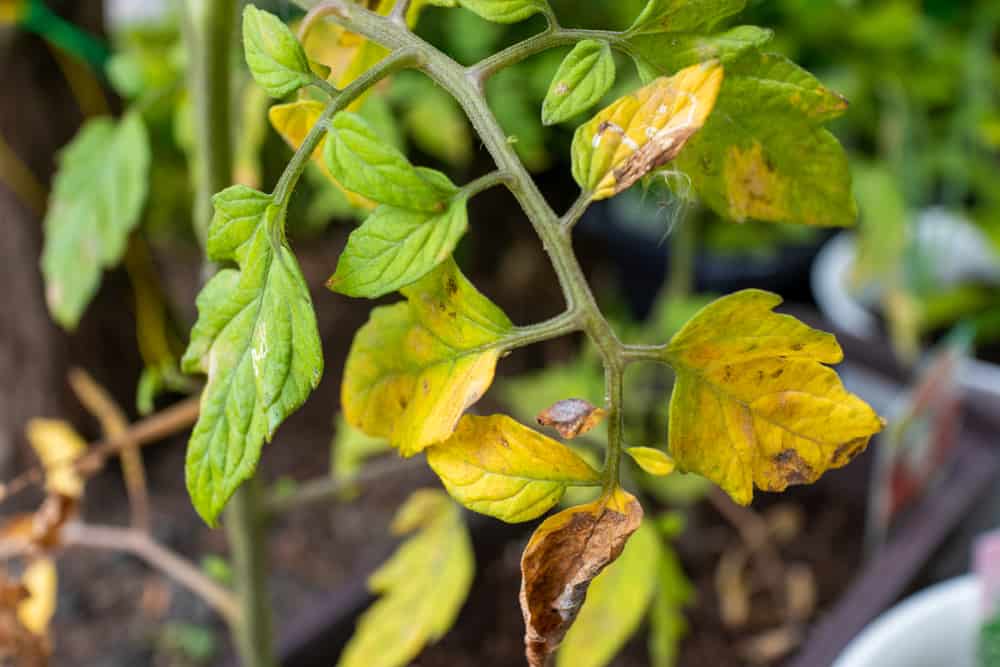
We all adore plants, particularly ones that provide us with luscious, fresh produce. It can be a frightening sight to see your tomato plant’s leaves turn yellow. A few yellow leaves on the plant are normal and should not be a cause for alarm.
However, if more than seventy percent of your plant’s leaves have turned yellow, it should raise concerns. There are many reasons behind the tomato leaves turning yellow. In this post, we will talk about those reasons and how you can fix them.
Transplant Shock
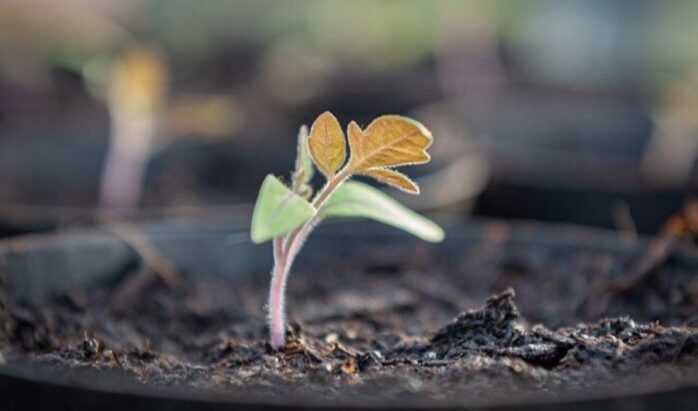
The leading cause of tomato plant leaves becoming yellow is usually transplant shock. Plants that are transplanted into the soil from a nursery or seedlings/plants that are re-potted experience transplanting shock. The stress that a newly transplanted plant experiences is referred to as “transplant shock.”
The roots of freshly transplanted plants may be poorly formed or disrupted, causing stress and preventing the roots from absorbing sufficient water and minerals. Pests and disease-causing bacteria can attack these plants, causing them to wilt and die if they aren’t properly cared for.
Tomatoes thrive in hot weather. They require a warm climate to acclimate to their new surroundings and develop. Plants undergo a time of transplant adjustment when transplanted during cooler circumstances. The plant’s older leaves begin to lighten and eventually turn yellow.
On the contrary, top leaves can look healthy and green. Transplant shock can cause the plants to slow down their growth, diminish the size of their leaves, and reduce the size of their internodes, decreasing the size of their branches, as well as disrupting flower formation and fruiting.
Solution:
Get rid of the yellow leaves. Only healthy leaves should be left on the plants. Pests and illnesses can be attracted to the yellow and fragile leaves. Water the plants regularly in sufficient amounts until they recover from the shock. Ensure that the plants are well-cared for and replant them in late spring when the weather is warm.
Sunlight Deficiency
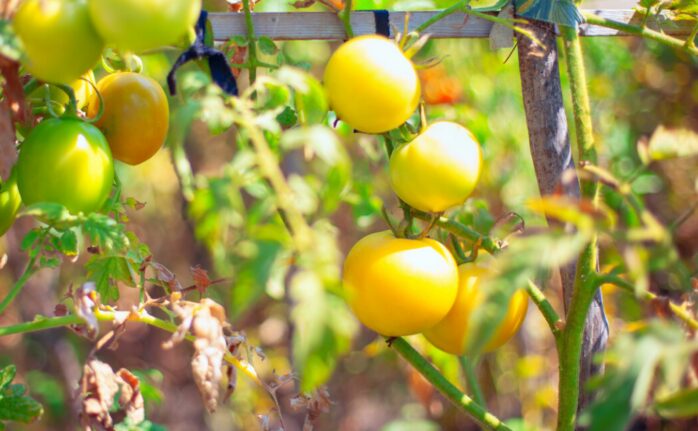
The culprit can sometimes be as simple as a lack of sunlight. Tomatoes, like peppers and eggplants, thrive in hot, sunny conditions with warm soil. There is nothing to be concerned about if only the bottom leaves are turning yellow. The plant’s newer leaves may just be limiting the sun’s full light from reaching the lower leaves.
Solution:
Simply move your tomato plant to a location with at least 6 hours of direct sunlight. Examine the higher leaves to see if the yellowing has spread. If you don’t, you’re fine. Simply pluck them off and toss them on top of your salad. Topdressing is the practice of applying organic materials to the topsoil for use as organic fertilizer.
Soil Nutrient Deficiencies

Another cause of yellow leaves on tomato plants is nitrogen-deficient soil. To encourage healthy plant stem and foliage growth, tomato plants need nitrogen.
A tomato plant will have withering leaves, stunted development, and spindly stems if it does not receive enough nitrogen. When applying more nitrogen, you must be careful not to overdo it since this can result in plant burn.
When tomatoes are planted year after year in the same garden bed, the soil becomes depleted, increasing the likelihood of yellow leaves. Calcium, magnesium, sulfur, and potassium are just a few of these nutrients, and depending on your soil type, one or more of them may be deficient.
Solution:
It’s crucial to rotate your crops every year by planting various veggies in different parts of your garden. Another fantastic option to address these deficiencies is to correct your soil’s composition with compost once a year, which will assist in developing a healthy microbial system in your soil. Tomato farmers know that testing the soil pH every few years is a good idea to ensure it is between 6.0 and 6.8.
Watering Mistakes
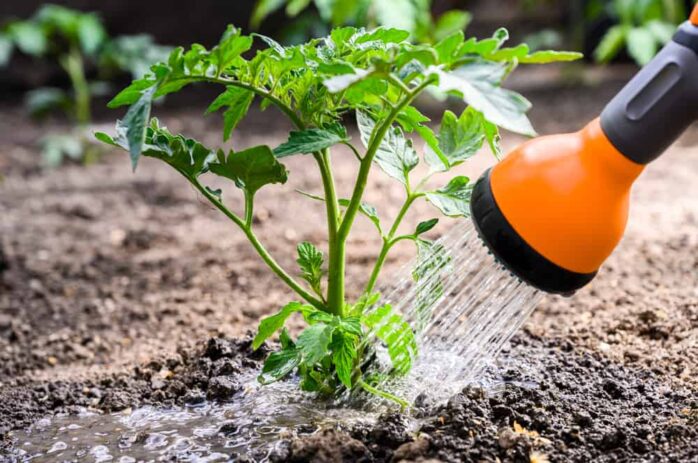
Yellow leaves in plants are most commonly caused by inadequate watering. Due to a variety of obligations, you may forget to water your plants regularly, allowing them to dry out. You can also overwater them at times.
The leaves wilt and become yellow when they are under-watered. The yellowing begins at the edges and progresses across the entire leaf, resulting in leaf fall.
When roots are suffocated by too much water, root rot develops. The amount of air available to the plants decreases if the roots are damaged, and the soil becomes moist. As a result, the plant’s leaves get yellow and fall off.
Solution:
Good watering habits are the most effective approach to address this. Water your plants when the top 1 to 2 inches of soil is dry, and never let them dry out.
Diseases And Pests
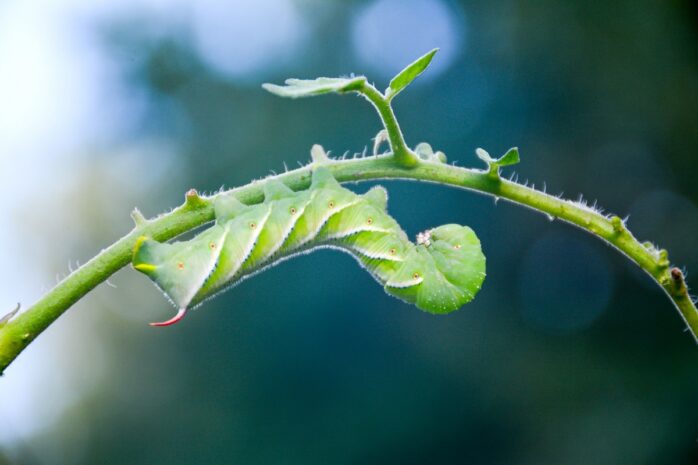
The presence of a disease or a pest is another reason why tomato plant leaves turn yellow. When the yellow leaves on the bottom spread upward, it could be a fungal or viral infection.
Yellow leaves with little dots or bulls-eye-like lesions are typical symptoms of an early fungal disease in tomatoes. This may or may not infect the fruits, depending on how bad the sickness is.
If it occurs, it’s a late blight, which can be identified by oily sores on the upper leaves and stems. Curly top virus or fusarium wilt are both possible causes. Chlorothalonil, a fungicide for plants, including tomatoes, can be used to treat the problem.
A virus could cause another condition. There are a variety of possible hazards when it comes to viral illnesses. Cucumber mosaic virus, tomato mosaic virus, tomato yellow leaf curl virus, single streak virus, and tobacco mosaic virus are examples of these viruses.
If the leaves have mosaic patterns, you can be sure it’s this. Pests such as spider mites, flea beetles, thrips, aphids, and whiteflies are commonly responsible for the development of viral infections in tomatoes.
Solution
Any of these pests can be eradicated with the use of high-quality chemical-based pest control compounds. A natural technique, such as horticultural oil or pesticide soap, can also be used.
Conclusion

Keep an eye out for any problems in your vegetable garden while you work. Early prevention is the key to a healthy garden and a fantastic harvest. Hopefully, some of these pointers will come in handy the next time you notice a few yellow leaves on your tomato plants. If not, visit Spider Farmer for more solutions.


